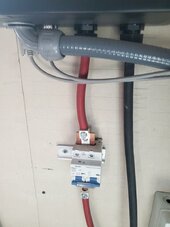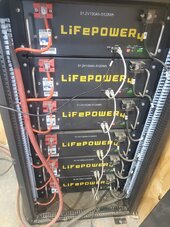Did you try to charge them one at a time? I had to individually isolate each battery and turn it on about 3 or 4 times to get it to start charging. When I tried with just the generator I couldn’t get it to work. (The battery would start charging, then the generator would rev up but I don’t think it did fast enough so the battery would stop charging. I could only get it to charge with solar and the generator) Do you get any lights at all?I had similar issue with this cold snap. System shutdown low SOC. 8 of the 10 batteries came back and charged ok. 2 are basically dead. the come up flashing red with an alarm. I broke them out of the battery bank and put them on the 18A charger but they will not charge.
hopefully SS will get back soon. sales gets back quickly once they have your money not so much.
You are using an out of date browser. It may not display this or other websites correctly.
You should upgrade or use an alternative browser.
You should upgrade or use an alternative browser.
71! on EG4 6500EX
- Thread starter jwoh
- Start date
Adam De Lay
Solar Wizard
The buzzing doesn't sound good.
I see that Error 71 (not F71) has to do with the battery not being able to discharge when communication is set up. From what I read, it seems like at least 1 cell has had a low voltage disconnect.
I realize it's winter time, but how often does your system get a full charge?
I see that Error 71 (not F71) has to do with the battery not being able to discharge when communication is set up. From what I read, it seems like at least 1 cell has had a low voltage disconnect.
I realize it's winter time, but how often does your system get a full charge?
Currently we haven't had good, consistent sun since mid December. During the summer my bank will charge in just 3-4 hours of sunlight but I doubt they have seen full charge (100%) in 4-5 weeks. They all hover around 75-90% during the day and drop down close to 60% right before sunrise.
I have pulled the buzzing batteries, all show over 80% SOC and I am charging them individually to 100% to try and reintroduce.
My best guess currently is that the lights on the face of the battery are not reflecting what the SOC actually is.
I am waiting on the USB cable from SS to see what is going on in the software side of these batteries.
I have pulled the buzzing batteries, all show over 80% SOC and I am charging them individually to 100% to try and reintroduce.
My best guess currently is that the lights on the face of the battery are not reflecting what the SOC actually is.
I am waiting on the USB cable from SS to see what is going on in the software side of these batteries.
Adam De Lay
Solar Wizard
Hmm. Yeah, I'm wondering if the lack of a full-charge has allowed the cells to become out of balance.Currently we haven't had good, consistent sun since mid December. During the summer my bank will charge in just 3-4 hours of sunlight but I doubt they have seen full charge (100%) in 4-5 weeks. They all hover around 75-90% during the day and drop down close to 60% right before sunrise.
I have pulled the buzzing batteries, all show over 80% SOC and I am charging them individually to 100% to try and reintroduce.
My best guess currently is that the lights on the face of the battery are not reflecting what the SOC actually is.
I am waiting on the USB cable from SS to see what is going on in the software side of these batteries.
The SOC lights on the front are just ranges.
Glad you're getting the cable for the battery because that would be my suggestion to see what's actually happening.
Does the 71 code on the inverter actually shut down the inverters?
I guess the biggest thing that is throwing me for a loop is that all but 2 of my batteries (I have removed these two for testing to not affect anything) will show all 4 SOC lights (75-100%) all the time, occasionally dropping down to 3 lights, and then I will get the 71! code around 7/8am. 71! will turn the inverters off until they get enough sunlight to power up, they will then charge the batteries for 2-3 hours before finally generating AC current.
It is honestly behaving like I would think it would if the batteries were all dead and flashing the fault lights however they all show all green.
It is honestly behaving like I would think it would if the batteries were all dead and flashing the fault lights however they all show all green.
Adam De Lay
Solar Wizard
Can you share a picture of how you have your batteries wired up to the inverters?I guess the biggest thing that is throwing me for a loop is that all but 2 of my batteries (I have removed these two for testing to not affect anything) will show all 4 SOC lights (75-100%) all the time, occasionally dropping down to 3 lights, and then I will get the 71! code around 7/8am. 71! will turn the inverters off until they get enough sunlight to power up, they will then charge the batteries for 2-3 hours before finally generating AC current.
It is honestly behaving like I would think it would if the batteries were all dead and flashing the fault lights however they all show all green.
What if you switch to USE instead of EG4?
Certainly.
2 battery banks of 6 batteries each, connected to bus bars, connected to inverters with 100a breakers.
I have USE instead of EG4 set on all inverters.
I was reading another thread where others recommended removing the comm cable between the inverter and batteries to avoid some other issues they had.
2 battery banks of 6 batteries each, connected to bus bars, connected to inverters with 100a breakers.
I have USE instead of EG4 set on all inverters.
I was reading another thread where others recommended removing the comm cable between the inverter and batteries to avoid some other issues they had.
Attachments
Adam De Lay
Solar Wizard
Thanks. Removing the comm cable and switching to USE should prevent the inverters from shutting down when a single battery has an issue.Certainly.
2 battery banks of 6 batteries each, connected to bus bars, connected to inverters with 100a breakers.
I have USE instead of EG4 set on all inverters.
I was reading another thread where others recommended removing the comm cable between the inverter and batteries to avoid some other issues they had.
You have 2 battery banks and 2 inverters? What are the extra 2 sets of cables for then?
Can you show how you have the battery stacks wired to the bus bars? I'm trying to see if your positive connection is on one end of the battery bank and the negative is on the other end. This allows for more even current distribution across the batteries in the bank.
Good eye, I knew the 2 extra cables would be a question - 2 additional 'backup' inverters. Original plan was to do 4 inverters for off grid, I was not impressed with the reliability of the inverters off the bat. I now have 2 inverters on and 2 off, when one inverter goes out I just switch on the other two inverters to not have any interruption in power as I diagnose.
Both banks have positive on one end and negative on the other end, photo below
I will pull the comm cable tonight, I would still leave all the battery comm cables between each other connected correct? It is just the main battery to the inverter I would be removing.
Both banks have positive on one end and negative on the other end, photo below
I will pull the comm cable tonight, I would still leave all the battery comm cables between each other connected correct? It is just the main battery to the inverter I would be removing.
Attachments
Adam De Lay
Solar Wizard
Thanks for the clarification!Good eye, I knew the 2 extra cables would be a question - 2 additional 'backup' inverters. Original plan was to do 4 inverters for off grid, I was not impressed with the reliability of the inverters off the bat. I now have 2 inverters on and 2 off, when one inverter goes out I just switch on the other two inverters to not have any interruption in power as I diagnose.
Both banks have positive on one end and negative on the other end, photo below
I will pull the comm cable tonight, I would still leave all the battery comm cables between each other connected correct? It is just the main battery to the inverter I would be removing.
Honestly, if you just change the protocol, you probably don't have to even pull the cable between the inverters and the master battery. I'm just guessing though as I don't have any EG4 batteries.
marionw
Solar Enthusiast
Don't know if you have downloaded the BMS_Tools software that will let you get detailed info on each battery;
You can run the software on a Mac or PC. Need an RS485 to USB Cable to talk to the batteries from your PC.
If you have have one battery (I assume in each stack) set as the master, it uses pins 7&8 of the RJ45 jacks to communicate with the other batteries.
Pins 1&2 are then used in the Master BMS to Inverter communications.
The communication cable to the PC will need to use pins 1&2.
In addition you can use the software to update the EG4 Lifepower4 battery firmware.
BMS Tool
You can run the software on a Mac or PC. Need an RS485 to USB Cable to talk to the batteries from your PC.
If you have have one battery (I assume in each stack) set as the master, it uses pins 7&8 of the RJ45 jacks to communicate with the other batteries.
Pins 1&2 are then used in the Master BMS to Inverter communications.
The communication cable to the PC will need to use pins 1&2.
In addition you can use the software to update the EG4 Lifepower4 battery firmware.
BMS Tool
EG4_Jared
Online Support for EG4 Electronics
Based on the details provided, it appears that the cells in certain batteries may have become imbalanced during this procedure. I suggest individually isolating each battery and testing their voltages to ensure a difference of no more than 0.5V between them. Once the read/write cable is in hand, it's advisable to update all batteries to the latest firmware. This update includes enhanced BMS logic designed to mitigate the occurrence of imbalances.Currently we haven't had good, consistent sun since mid December. During the summer my bank will charge in just 3-4 hours of sunlight but I doubt they have seen full charge (100%) in 4-5 weeks. They all hover around 75-90% during the day and drop down close to 60% right before sunrise.
I have pulled the buzzing batteries, all show over 80% SOC and I am charging them individually to 100% to try and reintroduce.
My best guess currently is that the lights on the face of the battery are not reflecting what the SOC actually is.
I am waiting on the USB cable from SS to see what is going on in the software side of these batteries.
Firmware for Lifepower4 Batteries: https://eg4electronics.com/categori...wer4-48v-100ah-lithium-iron-phosphate-battery
Does the cells being imbalanced explain the buzzing noise coming from the batteries?Based on the details provided, it appears that the cells in certain batteries may have become imbalanced during this procedure. I suggest individually isolating each battery and testing their voltages to ensure a difference of no more than 0.5V between them. Once the read/write cable is in hand, it's advisable to update all batteries to the latest firmware. This update includes enhanced BMS logic designed to mitigate the occurrence of imbalances.
Firmware for Lifepower4 Batteries: https://eg4electronics.com/categori...wer4-48v-100ah-lithium-iron-phosphate-battery
I had error 71 once. I put a 48v charger on the bus bar and turned off the 'good' batteries. Brought everything up to four lights, then let it go. I haven't had the same problem since, but have had full sun days in the meantime and have limited the load quite a bit.
I emailed SS, and their response was 'Fault 71 is a firmware version inconsistent. Each inverter needs to be updated to the same version.'
I decided to throw in the towel on the 6500ex and ordered the 18kPV. I struggled with the decision to buy any EG4 product, or switch to Schneider, Victron or others. I ordered my 6500's right at the end of the cycle. I had no idea I was ordering an obsolete product. Like buying a computer right before the next model comes out. I hope my solar future is less dramatic going forward. I just want something to work....and work well with minimal input from me.
I emailed SS, and their response was 'Fault 71 is a firmware version inconsistent. Each inverter needs to be updated to the same version.'
I decided to throw in the towel on the 6500ex and ordered the 18kPV. I struggled with the decision to buy any EG4 product, or switch to Schneider, Victron or others. I ordered my 6500's right at the end of the cycle. I had no idea I was ordering an obsolete product. Like buying a computer right before the next model comes out. I hope my solar future is less dramatic going forward. I just want something to work....and work well with minimal input from me.
Sounds like a lot of the responses I have received from them as well, you ask about error 71 and they tell you about fault 71.I had error 71 once. I put a 48v charger on the bus bar and turned off the 'good' batteries. Brought everything up to four lights, then let it go. I haven't had the same problem since, but have had full sun days in the meantime and have limited the load quite a bit.
I emailed SS, and their response was 'Fault 71 is a firmware version inconsistent. Each inverter needs to be updated to the same version.'
I decided to throw in the towel on the 6500ex and ordered the 18kPV. I struggled with the decision to buy any EG4 product, or switch to Schneider, Victron or others. I ordered my 6500's right at the end of the cycle. I had no idea I was ordering an obsolete product. Like buying a computer right before the next model comes out. I hope my solar future is less dramatic going forward. I just want something to work....and work well with minimal input from me.
I will do your recommendation today. I had a charger on just 1 battery all day yesterday and reintroduced it last night to the rack and the buzzing is gone and all seems okay with it.
I might have to do the same and give up on the 6500s, after the redundancies I have in place I didn't figure it would be much of an issue however if support is not there then what good is a warranty.
Adam De Lay
Solar Wizard
Unfortunately, this isn't the first time I've heard of issues where support is confusing the error code vs the fault code. Why the have the same codes....I stopped asking "why did they do that" a long time ago...
I agree though, disconnect and charge the "problem" batteries to full to let the cells balance and I would probably leave battery comms disconnected. I continually hear of problems with comms set up.
I agree though, disconnect and charge the "problem" batteries to full to let the cells balance and I would probably leave battery comms disconnected. I continually hear of problems with comms set up.
Update for everyone. I checked all my voltages a few days back, the batteries showing full SOC were putting out less than 45 volts, the batteries showing 75% SOC or under were the only ones actually within range, I guess the SOC lights don't really mean much. I charged each one individually and reintroduced to the racks over the last few days, we will see what happens as time goes on.
Similar threads
- Replies
- 1
- Views
- 248
- Replies
- 4
- Views
- 168
- Replies
- 1
- Views
- 463





